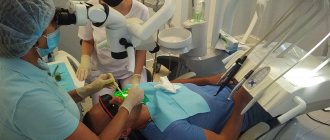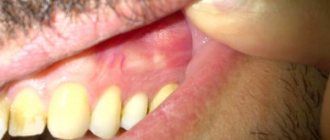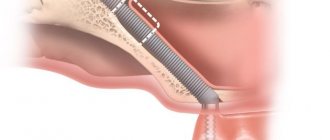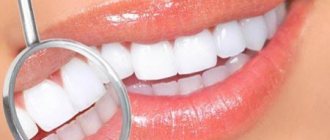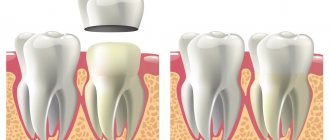Preparing teeth for prosthetics begins with an examination by an orthopedic dentist. It determines the scope and list of measures that will be required to effectively restore the integrity of the dentition.
The basis of preparation is accurate diagnosis. The condition of both jaws can be assessed using a panoramic X-ray - orthopantomogram. It allows:
- see the condition of all teeth;
- assess the condition, volume, structure of the bone tissue of the jaws;
- identify diseases that may interfere with prosthetics (periodontitis, root cysts, etc.);
- determine the condition of soft tissues, the depth of periodontal pockets with periodontal disease, etc.
Based on the diagnostic results, the doctor determines what preparation measures will be required.
Therapeutic preparation
Therapeutic preparation is necessary for the purpose of sanitation of the oral cavity. First of all, professional teeth cleaning is carried out:
- removal of hard dental deposits using ultrasound, less often - mechanical cleaning;
- removing soft plaque using the Air Flow method;
- polishing, fluoridation (remineralizing therapy).
Preparing teeth for prosthetics includes mandatory removal of foci of infection and inflammation. Treatment of caries and complications in the form of pulpitis, periodontitis is carried out, and therapy for inflammatory diseases of the gums and soft tissues of the oral cavity (periodontitis, gingivitis, glossitis, etc.) is prescribed.
Therapeutic preparation also includes removal of the pulp of teeth to be replaced. Afterwards, endodontic treatment is carried out - treatment and filling of the root canals.
Preparation for prosthetics for implantation
If implants are chosen as a support for the crown, the preparation of the oral cavity for prosthetics is the implantation itself and additional surgical operations for its implementation, such as bone grafting, sinus lifting, etc. The entire complex of measures for the implantation of artificial roots is carried out according to a high-precision digital protocol:
- CT and 3 D scanning of the jaws . Using computed tomography and intraoral scanning, a three-dimensional virtual model of the jaws is created, depicting the condition of the oral cavity with high accuracy and detail.
- Modeling of future crowns . The future orthopedic design is modeled digitally and the position and shape of the teeth are selected.
- Virtual placement of implants . The location of the implants is determined according to the virtual model of the jaw, taking into account future crowns, bone volume, localization of the facial nerves and other features.
- Making a surgical template . Based on a digital impression of the patient’s jaw, a real projection is made in the form of a positioning mouthguard, with the help of which it becomes possible to accurately comply with the selected conditions for the placement of the implant at the time of surgery.
- Implantation . Depending on the clinical situation, either classical two-stage implantation or implantation according to a one-stage and/or one-stage protocol is performed. After this, the process of osseointegration—engraftment of the implant into the bone—begins.
The long preparatory stage ends with permanent prosthetics - installation of a crown on an implant, usually screw-fixed. As a result of correctly performed implantation, the patient receives a flawless smile without any risks or complications.
Surgical preparation
Surgical preparation involves the removal of teeth that cannot be treated. For example, highly mobile ones, having a large root cyst, granulating periodontitis, etc.
Osteophytes and exostoses, if present, are also removed. They are outgrowths of bone tissue and can interfere with the installation of a denture.
Surgical preparation of teeth for prosthetics may also include removal of excess soft tissue due to hypertrophy of the mucous membranes and gums.
Implant placement also refers to surgical preparation. Osteoplastic surgery, the implantation of artificial or natural bone tissue to achieve the required volume of bone in the jaw, can also be used as a preliminary stage. One of the types of such an operation is a sinus lift, raising the bottom of the maxillary sinus.
How is prosthetics performed?
Once the oral cavity is prepared, the prosthetic process can begin. It consists of several stages:
- Preparation of teeth that will be involved in prosthetics: depulpation, removal of excess tissue.
- Taking impressions for subsequent production of a jaw model. Also, instead of impressions, intraoral photography can be used, followed by the formation of a three-dimensional digital model of the jaws.
- Design and manufacture of prosthesis.
- Fitting.
- Installation on permanent cement.
Orthopedic training
Orthopedic preparation involves attention to secondary tooth deformations after removal of those located nearby or “antagonist” (located on the opposite jaw) teeth. It involves creating special plates and trays to move protruding teeth to create space for dentures on the opposite jaw. It may also be necessary to make special trays to relieve the masticatory muscles. This is necessary for bruxism and increased muscle tone to prevent damage to structures.
Preparing teeth for prosthetics is a whole range of measures that are designed to prevent the difficulties of wearing artificial structures and are necessary to ensure oral health.
Why is it necessary to depulp teeth under metal-ceramics?
This question is very often asked by patients at the stage of preparation for metal-ceramic prosthetics . The name of this design makes it clear that it is based on metal, on top of which ceramic coating is applied, after which the prosthesis is fired in a special oven - this procedure ensures the strength of the connection between metal and ceramics. In order to ensure that after installation of the prosthesis it does not overestimate the bite and does not cause discomfort, it is necessary to create space; for this purpose, the supports are pre-prepared, removing the required amount of enamel and dentin. Thus, the layer of tissue protecting the pulp becomes much thinner. This often leads to so-called postoperative pain, increased sensitivity and the possible development of traumatic pulpitis, since the nervous tissue is highly sensitive. If, some time after installing the prosthesis, the tooth under the crown suddenly begins to hurt and become inflamed, then the entire structure will have to be removed, the resulting inflammation treated , and starting all over again.
Date of publication: September 20, 2020 Last update: September 22, 2021 © 2020 Professorial Dentistry “22 Century”. All rights reserved.
Insignia braces
Insignia braces are a relatively new development of American scientists, which have already managed to win the trust of doctors and patients. The main features of this bracket system:
- Individualization of braces based on patient impressions in a laboratory in the USA;
- Modeling of treatment stages in a computer program, which virtually eliminates errors when drawing up a treatment plan;
- The ability to see the result of treatment before it begins using a 3D model of the patient’s dental system;
- Super-precise simultaneous positioning of braces during installation (a special mouth guard is used);
- Reducing treatment time due to effective calculations;
- Suitable for the most difficult cases.
Preparation for orthodontic treatment with Insignia braces is as follows: the doctor takes high-precision impressions, from which a setup model is made. This model, showing the result of the planned treatment, is approved by the doctor in the presence of the patient. After this, a set of brackets and arches is ordered, which will be individualized in a laboratory in the USA for a given setup model. Insignia braces are returned to Moscow in a special mouthguard, which eliminates errors when fixing the system - the installation of braces occurs simultaneously. It takes about two months from taking impressions to fixing braces on the teeth - this is perhaps the only disadvantage of this system, especially if the patient is in a hurry to start treatment as soon as possible. However, the patient will spend the waiting time usefully: he will visit a dentist, osteopath, speech therapist and psychologist for consultation, and will cure dental caries if there is such a need. Closer to the time of installation of braces, you should visit a hygienist to prepare your teeth for the installation of braces. Additional consultations with specialists and hygienic cleaning are included in the treatment plan and are free for the patient.
After fixing braces on her teeth, the patient visited the doctor every month and a half. In addition, the patient visited osteopath T.Z. An for the correction of muscle tension arising from changes in the habitual but incorrect bite. Osteopathic correction helps reduce treatment time.
The next stage is wearing retention equipment and dental prosthetics, which must be done without delay in order to consolidate the results of orthodontic treatment. The orthodontist checks the condition of the teeth every 6 months
Treatment result
The duration of wearing the braces system was 22 months, the cost was 155 thousand rubles. With such a pathology, this is a very short treatment period, which was facilitated by sessions with an osteopath and the effectiveness of the selected brace system.
See other examples of bite correction at Dial-Dent here.
Prosthetics on implants
Preparatory work includes all necessary procedures. After this, in a two-stage protocol, they wait for the implants to take root, then make impressions and make dentures according to the general scheme.
With a one-stage protocol, the installation of temporary structures is provided immediately after implantation. After about a year, permanent dentures are made and installed. Prices for implant prosthetics may be higher, but the designs last longer and are more reliable, which makes the cost not as high as it seems at first glance.
At the ROOTT ICDC in Moscow, they carry out the entire range of preparatory measures for prosthetics. Our own laboratory, therapeutic, surgical, and orthopedic departments guarantee coordinated work of doctors and excellent results.
Expert of the article Alekperov Roman Borisovich Dentist-orthopedist, doctor of the first category
Work experience 24 years.
Prices for implantation using templates in Moscow
| Consultation with an orthopedist | FOR FREE |
| Installation of 1 implant | 20,000 rub. |
| Implant INNO, South Korea | 10,000 rub. |
| Implant MIS, Israel | 10,000 rub. |
| Implant NOBEL, Sweden | 35,000 rub. |
| Partial removable denture | 15,000 rub. |
| Complete removable denture | 20,500 rub. |
| Clasp prosthesis | RUB 25,500 |
| Ceramic crown | 21,000 rub. |
| Metal-ceramic crown | 5,100 rub. |
Orthodontic stage
Treatment is aimed at correcting malocclusion and occlusion (contact between the teeth of the upper and lower jaw). Teeth are moved using braces, aligners and plates. This is done not only to correct the bite, but also to correct the position of the supporting teeth and create a place for attaching dentures.
Installation of prostheses
When the crowns or dental bridges are ready, the final stage of prosthetics will begin. Installation of structures is carried out in accordance with the chosen method. If removable dentures are performed, the doctor shows the patient how to properly put on and remove the structure from the mouth. A specialist fixes permanent crowns and bridges in such a way that they are securely held on the supporting elements. There is no need to remove such dentures yourself; they remain in the oral cavity permanently.
Before installation, fittings are carried out to show whether adjustment (correction) of the structure is required. After the patient approves the prosthesis, the dentist performs its final fixation.
Consultation with an orthodontist and analysis of the situation, selection of medical equipment
At the initial consultation, the orthodontist formulated a diagnosis: retrognathic type of profile, distal skeletal bite, secondary deformation of the dentition, provoked by the lack of prosthetics of extracted teeth.
The orthodontist offered the patient several options for orthodontic treatment, which differ in the chosen brace system, timing and cost of treatment. The patient liked the Insignia braces most of all.
After agreeing to orthodontic treatment, the patient needs to undergo in-depth diagnostics (take a photograph for control and reporting on the stages of treatment, take a lateral and panoramic photograph of the teeth, visit related specialists: osteopath, dentist, hygienist). All this can be done at a convenient time at the Dial-Dent clinic. Administrators will select a convenient visit plan.
